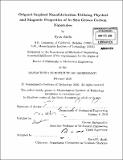Origami-inspired nanofabrication utilizing physical and magnetic properties of in situ grown carbon nanotubes
Author(s)
In, Hyun Jin
DownloadFull printable version (17.79Mb)
Other Contributors
Massachusetts Institute of Technology. Dept. of Mechanical Engineering.
Advisor
George Barbastathis.
Terms of use
Metadata
Show full item recordAbstract
Carbon nanotubes (CNTs), in particular the vertically-aligned variety grown through a plasma enhanced chemical vapor deposition (PECVD)-based process, are highly versatile nanostructures that can be used in a variety of nanomanufacturing applications. However, process and material compatibility issues have prevented the nanotubes from becoming more fully integrated into various micro- and nanomanufacturing applications. In this thesis, the integration of in situ CNT growth with a 3-D nanomanufacturing platform, namely the Nanostructured Origami TM process, will be shown. Due to the high temperatures involved in CNT growth, a new origami membrane material, titanium nitride (TiN), is introduced. This new origami membrane serves as an excellent diffusion barrier layer throughout the CNT growth process while promoting consistent nanotube growth and maintaining electrical conductivity to the CNTs. Various further modifications are made to the origami process, for example in metallization techniques, to accommodate the addition of CNTs to origami devices. Based on the presented CNT-origami process, a functioning microscale supercapacitor is also fabricated and tested. The integration of high surface area CNT electrodes with a unique 3-D device geometry results in a fabfriendly, high-performance supercapacitor that can easily be integrated as an onboard power source in self-powered microsystem applications. Finally, the magnetic properties of our in situ grown CNTs, derived from their naturally occurring, tip-encapsulated catalyst particles, will be characterized. Furthermore, these properties will be used to magnetically actuate, align, and latch individual as well as large arrays of CNTs and the entire membranes on which they are grown. The magnetic behaviors of CNTs and their underlying membranes will be investigated through computer simulation and experimental verification.
Description
Thesis (Ph. D.)--Massachusetts Institute of Technology, Dept. of Mechanical Engineering, 2010. Cataloged from PDF version of thesis. Includes bibliographical references (p. 123-133).
Date issued
2010Department
Massachusetts Institute of Technology. Department of Mechanical EngineeringPublisher
Massachusetts Institute of Technology
Keywords
Mechanical Engineering.